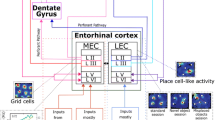Abstract
For animals as well as for humans, the hypothesis of multiple memory systems involved in different navigation strategies is supported by several biological experiments. However, due to technical limitations, it remains difficult for experimentalists to elucidate how these neural systems interact. We present how a computational model of selection between navigation strategies can be used to analyse phenomena that cannot be directly observed in biological experiments. We reproduce an experiment where the rat’s behaviour is assumed to be ruled by two different navigation strategies (a cue-guided and a map-based one). Using a modelling approach, we can explain the experimental results in terms of interactions between these systems, either competing or cooperating at specific moments of the experiment. Modelling such systems can help biological investigations to explain and predict the animal behaviour.
Preview
Unable to display preview. Download preview PDF.
Similar content being viewed by others
References
Trullier, O., Wiener, S.I., Berthoz, A., Meyer, J.A.: Biologically-based artificial navigation systems: review and prospects. Progress in Neurobiology 83(3), 271–285 (1997)
Filliat, D., Meyer, J.A.: Map-based navigation in mobile robots - i. a review of localisation strategies. Journal of Cognitive Systems Research 4(4), 243–282 (2003)
Meyer, J.A., Filliat, D.: Map-based navigation in mobile robots - ii. a review of map-learning and path-planning strategies. Journal of Cognitive Systems Research 4(4), 283–317 (2003)
Arleo, A., Rondi-Reig, L.: Multimodal sensory integration and concurrent navigation strategies for spatial cognition in real and artificial organisms. Journal of Integrative Neuroscience 6, 327–366 (2007)
Packard, M., McGaugh, J.: Double dissociation of fornix and caudate nucleus lesions on acquisition of two water maze tasks: Further evidence for multiple memory systems. Behavioral Neuroscience 106(3), 439–446 (1992)
White, N., McDonald, R.: Multiple parallel memory systems in the brain of the rat. Neurobiology of Learning and Memory 77, 125–184 (2002)
Kim, J., Baxter, M.: Multiple brain-memory systems: The whole does not equal the sum of its parts. Trends in Neurosciences 24(6), 324–330 (2001)
Poldrack, R., Packard, M.: Competition among multiple memory systems: Converging evidence from animal and human brain studies. Neuropsychologia 41(3), 245–251 (2003)
McIntyre, C., Marriott, L., Gold, P.: Patterns of brain acetylcholine release predict individual differences in preferred learning strategies in rats. Neurobiology of Learning and Memory 79(2), 177–183 (2003)
McDonald, R., Devan, B., Hong, N.: Multiple memory systems: The power of interactions. Neurobiology of Learning and Memory 82(3), 333–346 (2004)
Hartley, T., Burgess, N.: Complementary memory systems: Competition, cooperation and compensation. Trends in Neurosciences 28(4), 169–170 (2005)
Chavarriaga, R., Strosslin, T., Sheynikhovich, D., Gerstner, W.: A computational model of parallel navigation systems in rodents. Neuroinformatics 3(3), 223–242 (2005)
Pearce, J., Roberts, A., Good, M.: Hippocampal lesions disrupt navigation based on cognitive maps but not heading vectors. Nature 396(6706), 75–77 (1998)
Morris, R.: Spatial localisation does not require the presence of local cues. Learning and Motivation 12, 239–260 (1981)
Doeller, C.F., King, J.A., Burgess, N.: Parallel striatal and hippocampal systems for landmarks and boundaries in spatial memory. Proceedings of the National Academy of Sciences of the United States of America 105(15), 5915–5920 (2008)
Arleo, A., Gerstner, W.: Spatial cognition and neuro-mimetic navigation: A model of hippocampal place cell activity. Biological Cybernetics 83(3), 287–299 (2000)
Strösslin, T., Sheynikhovich, D., Chavarriaga, R., Gerstner, W.: Robust self-localisation and navigation based on hippocampal place cells. Neural Networks 18(9), 1125–1140 (2005)
Devan, B., White, N.: Parallel information processing in the dorsal striatum: Relation to hippocampal function. Neural Computation 19(7), 2789–2798 (1999)
Hamilton, D., Rosenfelt, C., Whishaw, I.: Sequential control of navigation by locale and taxon cues in the morris water task. Behavioural Brain Research 154(2), 385–397 (2004)
Martinet, L.E., Passot, J.B., Fouque, B., Meyer, J.A., Arleo, A.: Map-based spatial navigation: A cortical column model for action planning. In: Spatial Cognition (in press, 2008)
Filliat, D., Meyer, J.: Global localization and topological map-learning for robot navigation. In: Proceedings of the seventh international conference on simulation of adaptive behavior on From animals to animats table of contents, pp. 131–140 (2002)
Pych, J., Chang, Q., Colon-Rivera, C., Haag, R., Gold, P.: Acetylcholine release in the hippocampus and striatum during place and response training. Learning & Memory 12(6), 564–572 (2005)
Martel, G., Blanchard, J., Mons, N., Gastambide, F., Micheau, J., Guillou, J.: Dynamic interplays between memory systems depend on practice: The hippocampus is not always the first to provide solution. Neuroscience 150(4), 743–753 (2007)
Meyer, J., Guillot, A., Girard, B., Khamassi, M., Pirim, P., Berthoz, A.: The Psikharpax project: Towards building an artificial rat. Robotics and Autonomous Systems 50(4), 211–223 (2005)
Guazzelli, A., Corbacho, F.J., Bota, M., Arbib, M.A.: In: Affordances, motivations, and the world graph theory, pp. 435–471. MIT Press, Cambridge (1998)
Girard, B., Filliat, D., Meyer, J.A., Berthoz, A., Guillot, A.: Integration of navigation and action selection in a computational model of cortico-basal ganglia-thalamo-cortical loops. Adaptive Behavior 13(2), 115–130 (2005)
Author information
Authors and Affiliations
Editor information
Rights and permissions
Copyright information
© 2008 Springer-Verlag Berlin Heidelberg
About this paper
Cite this paper
Dollé, L., Khamassi, M., Girard, B., Guillot, A., Chavarriaga, R. (2008). Analyzing Interactions between Navigation Strategies Using a Computational Model of Action Selection. In: Freksa, C., Newcombe, N.S., Gärdenfors, P., Wölfl, S. (eds) Spatial Cognition VI. Learning, Reasoning, and Talking about Space. Spatial Cognition 2008. Lecture Notes in Computer Science(), vol 5248. Springer, Berlin, Heidelberg. https://doi.org/10.1007/978-3-540-87601-4_8
Download citation
DOI: https://doi.org/10.1007/978-3-540-87601-4_8
Publisher Name: Springer, Berlin, Heidelberg
Print ISBN: 978-3-540-87600-7
Online ISBN: 978-3-540-87601-4
eBook Packages: Computer ScienceComputer Science (R0)




